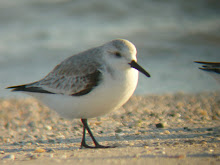I have recently developed an interest in the Digiscoping technique. Michigander Jerry Jourdan's Blog or Wisconsin Based Mike McDowell for instance, shows some miraculous (depending of my mood, I sometimes found them disgustingly sharp and perfect) avian pictures, just by the use of a (high end) scope, a tiny point and (good) point & shoot camera, and a generally hand made adaptor. All my tries so far had been exclusively hand held (no adaptor, no shutter release), and the results were ranging from extremely bad to barely mediocre. Facing the reality of tough economic times, and without having $5,000 to spend into a DSLR camera equipped with a disproportionate appendix (I am not not sure if I would like to carry one of these things anyway), I thought this technique was certainly worth exploring.
So armed with various handsaw and other curiously inefficient tools, I managed to create a decent adaptor from a plastic cup. The results can be certainly greatly improved by using power tools, but I guess I did it only to give me a taste of the technique.
The first results are shown below. In fact the first pictures I really took were a box of vitamins on the other side of the yard, but, I choose to show birds instead. I quickly found out that the mode "quick burst" of my tiny camera had the great advantage of taking 10 frames a second, thus increasing statistically the chances to obtain one decent shot. On the down side, though, this mode "push" automatically the camera into the high ISOs (800) which theoretically should increase the graininess of the shot. In addition, the camera reduces the size of the picture to only 2.3 mega pixels, instead of the 8 or 5. But I thought it was a good starting point.

American Goldfinch, digiscoped

Pine Siskin, digiscoped

Female Downy Woodpecker, digiscoped
Results were not too bad for a first try, but I had to try on further birds.

Biking Path in Gallup Park
I first spotted a group of Common Mergansers swimming at about 150 feet away. I thought it was a good starting point. Ok, here is my adaptor, I set up my scope and try to attach my camera to the adaptor. Mmm not easy with these big gloves. Ok I'll take them off. Ok, now I try to set up the camera to the proper mode, despite the velcro bands that partially cover the buttons. MMM not easy.
I take a few shots of the Mergansers. Left hand fingers on the focus knob, right hand on the camera. Boy, it is cold here

digiscoped Common Merganser defending his freedom of speech

Male Hooded Merganser, digiscoped
After 2-3 minutes, my fingers are numb, and I have to reluctantly admit my defeat. I quickly come back to my car and tried to warm up my fingers. Slowly, Painfully, sensation comes back and I am ready for another walk. This time I decided to only take my binoculars and the camera.
Despite the cold, there was a feeling that spring was not too far away. Numerous chikadees were singing, as well as several Tufted Titmice and Cardinals. Along the sidewalk I spot several bluebirds.
As I walk leisurely on the path, I can not help but thinking about the spring that will come soon. Already the first redwinged blackbirds have been spotted in the county, and a few tree swallows were found on the shore of lake Erie. In a bit more than a month, we should be able to see the first warblers, probably a yellow rumped.
And maybe, more chances to train for digiscoping in warmer weather!!!!!






2 comments:
WOW! You did a great job!
I may follow your advice really soon ;)
extra... ça valait la peine!
Post a Comment